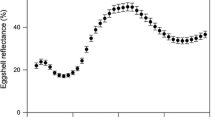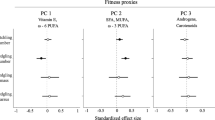Abstract
Recently, evidence is mounting that females can adaptively engineer the quality of their offspring via the deposition of yolk compounds, including carotenoids and androgens. In this study, we simultaneously consider how both carotenoids and androgens in egg yolk relate to parental quality in barn swallows (Hirundo rustica erythrogaster). First, we found no relationship between concentrations or amounts of yolk androgens and carotenoids. Yolk carotenoids decreased with laying order, whereas we found no relationship between yolk androgens and laying order. Second, we tested the Investment Hypothesis, which predicts that high-quality females or females paired to high quality mates, allocate differentially more of these yolk compounds to their offspring. For carotenoids, we mostly found evidence to counter predictions of the Investment hypothesis: (1) Carotenoid concentrations varied among females, (2) heavier eggs contained lower carotenoid concentrations, although heavier yolks contained greater amounts of carotenoids, (3) eggs of earlier-laying females had lower concentrations in their eggs, and (4) yolk carotenoids were not correlated with clutch size or male plumage ornamentation. For androgens, we found weak support for the Investment Hypothesis: (1) Yolk androgens varied among females, (2) heavier eggs and yolks contained greater amounts, although not concentrations of androgens, (3) females paired to more colorful males laid eggs with greater concentrations of androgens, and (4) no effects of laying date or morphological correlates of female quality on androgen concentrations in egg yolks. Overall, these findings suggest that each yolk compound may have different functions and therefore may be regulated by different mechanisms.




Similar content being viewed by others
References
Ardia DR (2005) Individual quality mediates tradeoffs between reproductive effort and immune function in tree swallows. J Anim Ecol 74:517–524
Badyaev AV, Acevedo Seaman D, Navara KJ, Hill GE, Mendonca T (2006) Evolution of sex-biased maternal effects in birds. III. Adjustment of ovulation order can enable sex-specific allocation of hormones, carotenoids, and vitamins. J Evol Biol 19:1044–1057
Blount JD, Surai PF, Nager RG, Houston DC, Moller AP, Trewby ML, Kennedy MW (2002) Carotenoids and egg quality in the lesser black-backed gull Larus fuscus: a supplemental feeding study of maternal effects. Proc R Soc Lond B 269:29–36
Bortolotti GR, Negro JJ, Surai PR, Prieto P (2003) Carotenoids in eggs and plasma of red-legged partridges: effects of diet and reproductive output. Physiol Biochem Zool 76:367–374
Brown CR, Brown MB (1999) Barn swallow (Hirundo rustica). No. 42. In: Poole A, Gill F (eds) The birds of North America. The Birds of North America, Philadelphia, PA, pp 1–32
Brown CR, Sherman LC (1989) Variation in the appearance of swallow eggs and the detection of intraspecific brood parasitism. Condor 91:620–627
Burley N (1988) The differential-allocation hypothesis: an experimental test. Am Nat 132:611–628
Drent RH, Daan S (1980) The prudent parent: Energetic adjustment in avian breeding. Ardea 68:225–252
Eising CM, Eikenaar C, Schwabl H, Groothuis TGG (2001) Maternal androgens in black-headed gull (Larus ridibundus) eggs: consequences for chick development. Proc R Soc Lond B 268:839–846
Eising CM, Muller W, Groothuis TGG (2006) Avian mothers create different phenotypes by hormone deposition in their eggs. Biol Lett 2:20–22
Gil D, Graves J, Hazon N, Wells A (1999) Male attractiveness and differential testosterone investment in zebra finch eggs. Science 286:126–128
Gil D, Lebouche G, Lacroix A, Cue R, Kreutzer M (2004) Female canaries produce eggs with greater amounts of testosterone when exposed to preferred male song. Horm Behav 45:64–70
Gil D, Ninni P, Lacroix A, deLope F, Tirard C, Marzal A, Møller AP (2005) Yolk androgens in the barn swallow Hirundo rustica: a test of some adaptive hypotheses. J Evol Biol 19:123–131
Groothius TCC, Muller W, Engelhardt NV, Carere C, Eising C (2005) Maternal hormones as a tool to adjust offspring phenotype in avian species. Neurosci Biobehav Rev 9:329–352
Groothius TCC, Eising CM, Blount JD, Surai P, Apanius V, Dijkstra C, Muller W (2006) Multiple pathways of maternal effects in black-headed gulls: constraint and adaptive compensatory adjustment. J Evol Biol 19:1304–1313
Gwinner H, Schwabl H (2005) Evidence for sexy sons in European starlings (Sturnis vulgaris). Behav Ecol Sociobiol 58:375–382
Hill GE (1998) An easy, inexpensive means to quantify plumage coloration. J Field Ornithol 69:353–363
Ketterson ED, Nolan V (1999) Adaptation, exaptation, and constraint: a hormonal perspective. Am Nat 154:S2–S25
Krinsky NI (2001) Carotenoids as antioxidants. Nutrition 17:815–817
Lipar JL, Ketterson ED (2000) Maternally derived yolk testosterone enhances the development of the hatching muscle in the red-winged blackbird Agelaius phoeniceus. Proc R Soc Lond B 267:2005–2010
Lipar JL, Ketterson ED, Nolan V, Casto JM (1999) Egg yolk layers vary in the concentration of steroid hormones in two avian species. Gen Compar Endocrinol 115:220–227
Littell RC, Milliken GA, Stroup WW, Wolfinger RD (2002) SAS system for mixed models. SAS Institute, Cary, NC
Marshall RC, Leisler B, Catchpole CK, Schwabl H (2005) Male song quality affects circulating but not yolk steroid concentrations in female canaries (Serinus canaria). J Exp Biol 208:4593–4598
McGraw KJ (2006) Carotenoids mediate a trade-off between egg quantity and quality in Japanese quail. Ethol Ecol Evol 18:247–256
McGraw KJ, Ardia DR (2003) Carotenoids, immunocompetence, and the information content of sexual colors: an experimental test. Am Nat 162:704–712
McGraw KJ, Hill GE, Stradi R, Parker RS (2002) The effect of dietary carotenoid access on sexual dichromatism and plumage pigment composition in the American goldfinch. Comp Biochem Physiol B 131(2):261–269
McGraw KJ, Adkins-Regan E, Parker RS (2005) Maternally derived carotenoid pigments affect offspring survival, sex ratio, and sexual attractiveness in a colourful songbird. Naturwissenschaften 92:375–338
Moreno-Rueda G (2007) Yolk androgen deposition as a female tactic to manipulate paternal contribution. Behav Ecol 18:496–498
Müller W, Groothuis TGG, Kasprizik A, Dijkstra C, Alatalo RV, Sittari H (2005) Prenatal androgen exposure modulates cellular and immune function of black-headed gull chicks. Proc R Soc Lond B 272:1971–1977
Navara KJ, Hill GE, Mendonca MT (2005) Variable effects of yolk androgens on growth, survival, and immunity in eastern bluebird nestlings. Physiol Biochem Zool 78:570–578
Navara KJ, Badyaev AV, Mendonca MT, Hill GE (2006) Yolk antioxidants vary with male attractiveness and female condition in the house finch (Carpodacus mexicanus). Physiol Biochem Zool 79:1098–1105
Neuman CR, Safran RJ, Lovette IJ (2007) Male tail streamer length does not predict apparent or genetic reproductive success in north American barn swallows Hirundo rustica erythrogaster. J Avian Biol 38:28–36
Pilz KM, Smith HG (2004) Egg yolk androgen levels increase with breeding density in the European Staring Sturnus vulgaris. Funct Ecol 18:58–66
Pilz KM, Smith HG, Sandell M, Schwabl H (2003) Inter-female variation in egg yolk androgen allocation in the European starling: Do high quality females invest more? Anim Behav 65:841–850
Pilz KM, Quiroga M, Schwabl H, Adkins-Regan E (2004) European starling chicks benefit from high yolk testosterone levels during a drought year. Horm Behav 46:179–192
Price T (1998) Maternal and paternal effects in birds: effects on offspring fitness. In: Mousseau TA, Fox CW (eds) Maternal effects as adaptations. Oxford University Press, Oxford, pp 202–226
Royle NJ, Surai PF, McCartney RJ, Speake BK (1999) Parental investment and egg yolk lipid composition in gulls. Funct Ecol 3:298–306
Royle NJ, Surai PF, Hartley IR (2001) Maternally derived androgens and antioxidants in bird eggs: complementary but opposing effects? Behav Ecol 12:381–385
Royle NJ, Surai PF, Hartley IR (2003) The effect of variation in dietary intake on maternal deposition of antioxidants in zebra finch eggs. Funct Ecol 17:472–481
Rutstein AN, Gilbert L, Slater PJB, Graves JA (2005) Sex-specific patterns of yolk androgen allocation depend on maternal diet in the zebra finch. Behav Ecol 16:62–69
Safran RJ (2004) Adaptive site selection rules and variation in group size of barn swallows: individual decisions predict population patterns. Am Nat 164:121–131
Safran RJ, McGraw KJ (2004) Plumage coloration, not length or symmetry of tail-streamers, is a sexually selected trait in North American barn swallows. Behav Ecol 15:455–461
Safran RJ, Neuman CR, McGraw KJ, Lovette IJ (2005) Dynamic paternity allocation as a function of male plumage color in barn swallows. Science 309:2210–2212
Saino N, Primmer CR, Ellegren H, Møller AP (1997) An experimental study of paternity and tail ornamentation in the barn swallow (Hirundo rustica). Evolution 51:562–570
Saino N, Bertacche V, Ferrari RP, Martinelli R, Møller AP, Stradi R (2002) Carotenoid concentration in barn swallow eggs is influenced by laying order, maternal infection, and paternal ornamentation. Proc R Soc Lond B 269:1729–1733
Saino N, Ferrari RP, Romano M, Martinelli R, Møller AP (2003) Experimental manipulation of egg carotenoids affects immunity in barn swallow nestlings. Proc R Soc Lond B 270:2485–2489
Saino N, Ferrari RP, Romano M, Martinelli R, Lacroix A, Gil D, Møller AP (2006) Maternal allocation of androgens and antagonistic effects of yolk androgens on sons and daughters. Behav Ecol 17:172–181
Schwabl H (1993) Yolk is a source of maternal testosterone for developing birds. Proc Nat Acad Sci 90:11446–11450
Schwabl H (1996) Maternal testosterone in the avian egg enhances postnatal growth. Compar Biochem Physiol 114A:271–276
Schwabl H (1997) Maternal androgen hormones in the egg. In: Harvey S, Etches RJ (eds) Perspectives in avian endocrinology. Journal Endocrinology, Bristol, pp 3–13
Sockman KW, Schwabl H (2000) Yolk androgens reduce offspring survival. Proc R Soc Lond B 267:1451–1456
Surai PF, Speake BK, Wood NAR, Blount JD, Bortolotti GR, Sparks NHC (2001) Carotenoid discrimination by the avian embryo: a less from wild birds. Comp Biochem Physiol B 128:743–750
Tanvez A, Beguin N, Chastel O, Lacroix A, Leboucher G (2004) Sexually attractive phrases increase yolk androgens deposition in Canaries (Serinus canaries). Gen Comp Endocrinol 138:113–120
Van Noordwijk AJ, de Jong G (1986) Acquisition and allocation of resources: their influence on variation in life history tactics. Am Nat 128:137–142
Verboven N, Evans NP, D’alba L, Nager RG, Blount JD, Surai PF, Monaghan P (2005) Intra-specific interactions influence egg composition in the lesser black-backed gull (Larus fuscus). Behav Ecol Sociobiol 57:357–365
Williams TD (2005) Mechanisms underlying the costs of egg production. Bioscience 55:39–48
Wingfield JC, Farner DS (1975) The determination of five androgens in avian plasma by radioimmunoassay and competitive protein-binding. Androgens 26:311–327
Acknowledgments
John Anderson and Maura Byrne were invaluable during the field portion of this study. Funding for this study was obtained by the Cornell University chapter of Sigma Xi and the American Museum of Natural History. R.J. Safran was supported by an American Association of University Women Fellowship during data collection and a Princeton University Council on Science and Technology Fellowship during manuscript preparation; K.M. Pilz was supported by a Howard Hughes Medical Institute Predoctoral Fellowship, K.J. McGraw was supported by an EPA STAR Fellowship, and S. Correa was supported by a SUNY Minority Fellowship during the data collection phase of this project. We acknowledge the insightful comments of the Hau and Wikelski Labs at Princeton University, Ian Hartley, and two anonymous reviewers whose suggestions greatly improved our manuscript. Permission to collect eggs was granted by the US Fish and Wildlife Service and the New York Department of Environmental Conservation.
Author information
Authors and Affiliations
Corresponding author
Additional information
Communicated by I. Hartley
Rights and permissions
About this article
Cite this article
Safran, R.J., Pilz, K.M., McGraw, K.J. et al. Are yolk androgens and carotenoids in barn swallow eggs related to parental quality?. Behav Ecol Sociobiol 62, 427–438 (2008). https://doi.org/10.1007/s00265-007-0470-7
Received:
Revised:
Accepted:
Published:
Issue Date:
DOI: https://doi.org/10.1007/s00265-007-0470-7




